The Skull Nebula is a bright planetary nebula located approximately 1,600 light-years away in the constellation Cetus. With an apparent magnitude of 8, it can be seen in a small telescope. The nebula has the designation NGC 246 in the New General Catalogue and is catalogued as Caldwell 56 in the Caldwell catalogue.
The nebula gets its name from its striking resemblance to a human skull in images. Like all planetary nebulae, it formed when an aging Sun-like star cast away its outer layers, leaving behind a hot glowing stellar remnant.
When low to intermediate-mass stars evolve into red giants near the end of their life cycles, they lose mass through a strong stellar wind. The expelled material from the aging star forms the nebula’s outer shells. As the central red giant keeps losing material, it becomes surrounded by increasingly complex shells of ionized gas. Once the star has lost all of its atmosphere, the intense ultraviolet radiation from its exposed luminous core ionizes the expelled material, causing the gas to glow as a bright planetary nebula.
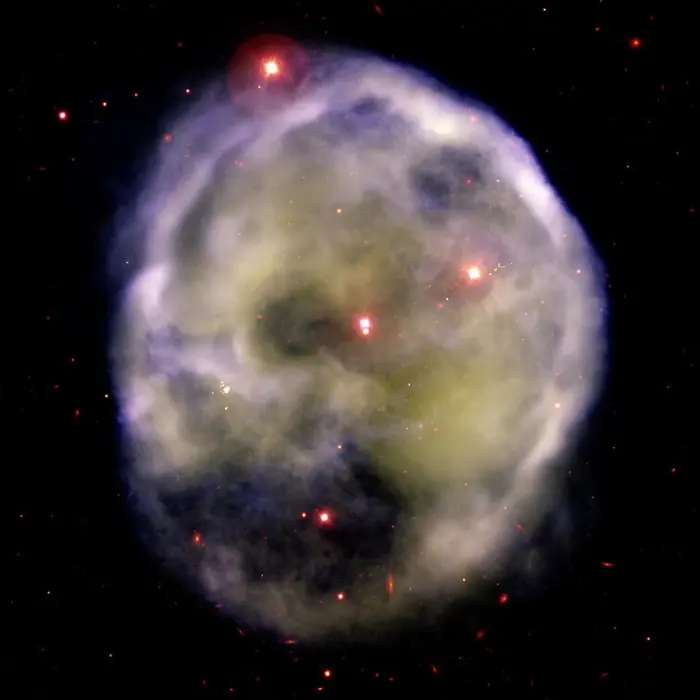
Gemini South Image of the planetary nebula NGC 246. The complex braided structure of NGC 246’s blue outer ring is most likely due to the action of shock waves. As the compressed outer shell piles up against the interstellar medium like plowed snow on a roadway, it heats up and becomes unstable. The ring starts to fray and fragment. High-velocity gases pushing outward from the hot (~200,000 degrees K) central star may also contribute to the visible chaos. Collisions between these fast winds and the shocked shell could explain the distinctive green lobes and darker voids visible in the leading half of NGC 246’s interior shell. Image credit: International Gemini Observatory, Travis Rector, University of Alaska Anchorage, National Optical-Infrared Astronomy Research Laboratory (NOIRLab) (CC BY 4.0 DEED)
The central star of NGC 246 illuminates the expanding clouds of material and will continue to do so for a few more millennia. Eventually, it will cool down and fade, and the clouds of gas and dust will disappear into the interstellar medium.
The Skull Nebula has a slightly elliptical shape and an apparent diameter of about 224 arcseconds. It is a relatively old planetary nebula with a dynamical age of about 6,600 years. It expands at 39.5 km/s.
The hot blue planetary nebula nucleus (PNN) is moving through space at about 80 km/s. The gas in the nebula’s leading edge moves in the same direction as the star. As it collides with the interstellar medium, the gas slows down as is compressed. It becomes hotter and unstable, giving the nebula’s ring a brighter and sharper appearance and producing an asymmetric appearance along the major axis of NGC 246. The material on the nebula’s trailing edge expands freely. The progenitor star is slightly offset toward the leading edge.
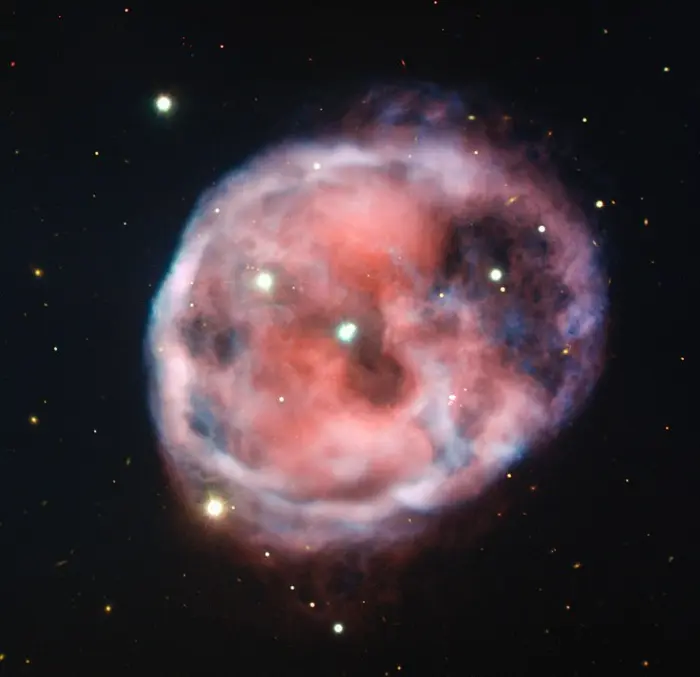
Captured in astounding detail by ESO’s Very Large Telescope (VLT), the eerie Skull Nebula is showcased in this image in beautiful pink and red tones. This planetary nebula, also known as NGC 246, is the first known to be associated with a pair of closely bound stars orbited by a third outer star. Taken by the FORS 2 instrument on ESO’s VLT in the Chilean Atacama Desert, this image of the Skull Nebula intentionally captures light emitted in some narrow ranges of wavelengths — those associated with hydrogen and oxygen gas. Observations of light emitted by particular elements help reveal a wealth of information about an object’s chemical and structural compositions. This image of the Skull Nebula highlights where NGC 246 is rich or poor in hydrogen (shown in red) and oxygen (depicted in light blue). Image credit: (CC BY 4.0 DEED)
The star in the heart of the nebula is a 12th magnitude white dwarf catalogued as HIP 3678 A. It has an effective temperature of about 150,000 K and a mass of 0.84 solar masses. The values were obtained in a study conducted in 1998. The progenitor star would have had a mass of around 4.3 solar masses and a main sequence lifetime of about 260 million years.
In 1930, the central star had a photographic magnitude as bright as 9th magnitude. Its brightness gradually dropped to magnitude 11.2 by 1969, and today the star shines at 12th magnitude.
The white dwarf has two companions, HIP 3678 B and HIP 3678 C. The companions have estimated masses of 0.85 and 0.1 solar masses. HIP 3678 B is believed to be an early to mid-K type dwarf and HIP 3678 C a dim red dwarf of the spectral type M5-M6.
HIP 3678 B lies at a separation of about 3.8 arcseconds from the nebula’s central star. It was first detected by Minkowski in 1965 and confirmed by Cudworth in 1973.
The third star in the system, HIP 3678 C, was detected about 1 arcsecond away from the primary, at a projected separation of around 500 astronomical units, in 2014. The discovery made NGC 246 the first known planetary nebula with a hierarchical triple stellar system at its core.
The second companion was discovered by C. Adam and M. Mugrauer of the Astrophysical Institute and University Observatory in Jena, Germany. The astronomers analyzed near infrared and visual data obtained with the adaptive optics imager NACO at the Very Large Telescope (VLT) at the Paranal Observatory in the Atacama Desert in Chile and the Wide Field Planetary Camera 2 aboard the Hubble Space Telescope (HST). The data used in the study was taken from Hubble and the European Southern Observatory (ESO) archives.
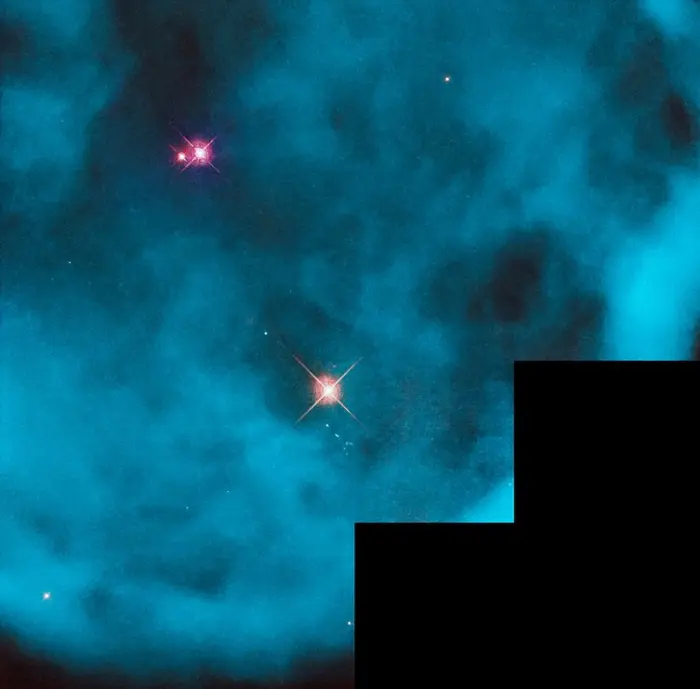
This serene view captures a portion of the planetary nebula NGC 246, also known as Caldwell 56. Planetary nebulae are named such because when they were first observed through early telescopes, they resembled planets. However, a planetary nebula is actually the final stage in the evolution of a star that is similar to our Sun. As the star reaches the end of its life, pulsations and strong stellar winds eject the star’s envelopes of gas. The hot, compact core of the star emits intense radiation, causing the gas to glow for a few tens of thousands of years before the nebula dissolves, leaving behind a white dwarf like the one at the center of Caldwell 56. The image above was captured by Hubble’s Wide Field and Planetary Camera 2. It provides a detailed look at the structure of Caldwell 56 and its central star. These observations, and subsequent ones, were taken to better understand how the wispy filaments in a planetary nebula change over time. Image credit: NASA, ESA, J. Westphal (California Institute of Technology), and K. Werner (Eberhard Karls Universitat); Processing: Gladys Kober (NASA/Catholic University of America) (CC BY 2.0 DEED)
Facts
The Skull Nebula was discovered by the German-born British astronomer William Herschel on November 27, 1785. Herschel discovered the nebula with his 18.7-inch reflector with a focal length of 20 feet. He catalogued the object as V 25. The “V” stood for very large nebulae.
NGC 246 shares the nickname the Skull Nebula with the brighter and better-known emission nebula NGC 2237, also known as the Rosette Nebula, in the Monoceros constellation. The two nebulae are not to be confused. The Rosette is a large star-forming complex located 5,200 light-years away and NGC 246 is a small remnant of a single star.
NGC 246 is sometimes also called the Pac-Man Nebula because the arrangement of stars in the nebula’s field of view is reminiscent of the character in the 1980s video game. The nebula is not to be confused with the other Pacman Nebula (NGC 281), an emission nebula in the region of Cassiopeia’s W in the Cassiopeia constellation.
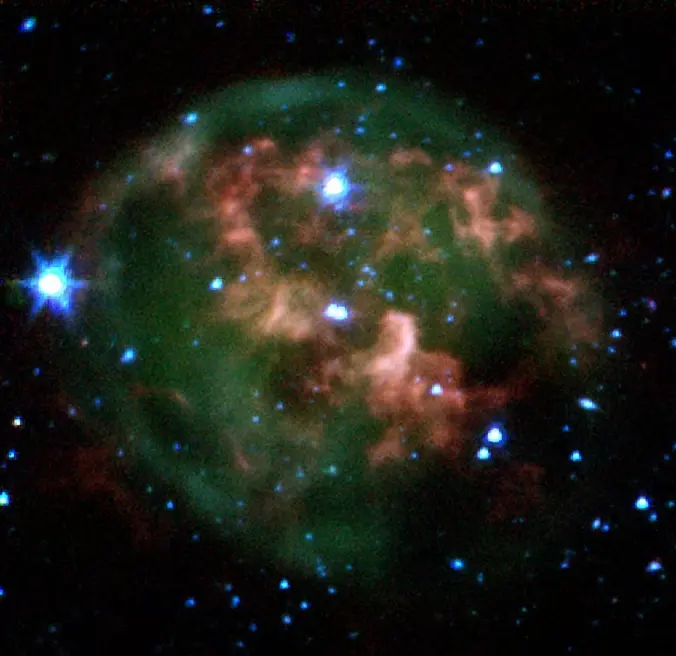
This image from NASA’s Spitzer Space Telescope shows the central star of the Skull Nebula (center) surrounded by a cloud of glowing gas and dust. Spitzer has pierced through the dust to highlight a never-before-seen feature — a giant ring of material (red) slightly offset from the cloud’s core which consists of material that was expelled from the aging star. This image composite was taken on Dec. 6, 2003, by Spitzer’s infrared array camera, and is composed of images obtained at four wavelengths: 3.6 microns (blue), 4.5 microns (green), 5.8 microns (orange) and 8 microns (red), image credit: NASA/JPL-Caltech/J. Hora (Harvard-Smithsonian CfA)
The Skull Nebula is one of about a dozen planetary nebulae included in Sir Patrick Moore’s Caldwell catalogue. The catalogue serves as a complement to the Messier catalogue and, unlike Charles Messier’s list, it includes deep sky objects in the far southern sky. All Caldwell and Messier objects can be observed in amateur telescopes. Many of them are visible with binoculars.
Other planetary nebulae with Caldwell designations include the Bow-Tie Nebula (Caldwell 2) in the constellation Cepheus, the Cat’s Eye Nebula (Caldwell 6) in Draco, the Blinking Planetary Nebula (Caldwell 15) in Cygnus, the Blue Snowball Nebula (Caldwell 22) in Andromeda, the Saturn Nebula (Caldwell 55) and the Helix Nebula (Caldwell 63) in Aquarius, the Ghost of Jupiter (Caldwell 59) in Hydra, the Butterfly Nebula (Caldwell 69) in Scorpius, and the Southern Ring Nebula (Caldwell 74) in Vela.
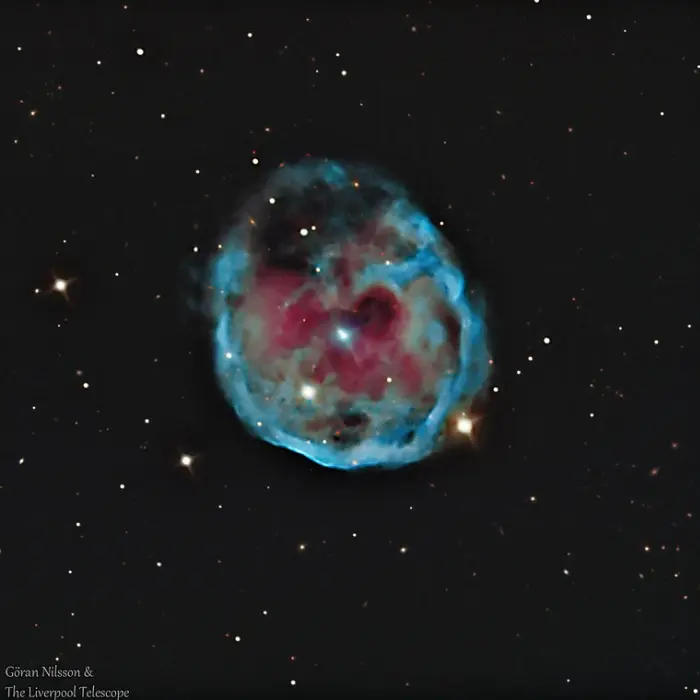
HaRGB image of The Skull Nebula (NGC 246), credit: Göran Nilsson & The Liverpool Telescope (CC BY-SA 4.0 DEED)
Location
The Skull Nebula is located in the southern part of the equatorial constellation Cetus (the Sea Monster or the Whale). It lies in the region of the Sea Monster’s belly and tail, about 6 degrees north-northeast of the orange giant Diphda (Beta Ceti). Shining at magnitude 2.02, Diphda is the brightest star in Cetus. It is the brightest star near the imaginary line extended from Alpheratz through Algenib in the Great Square of Pegasus. NGC 246 appears about 1.5 degrees south-southeast of the fainter orange giant Phi1 Ceti (mag. 4.75).
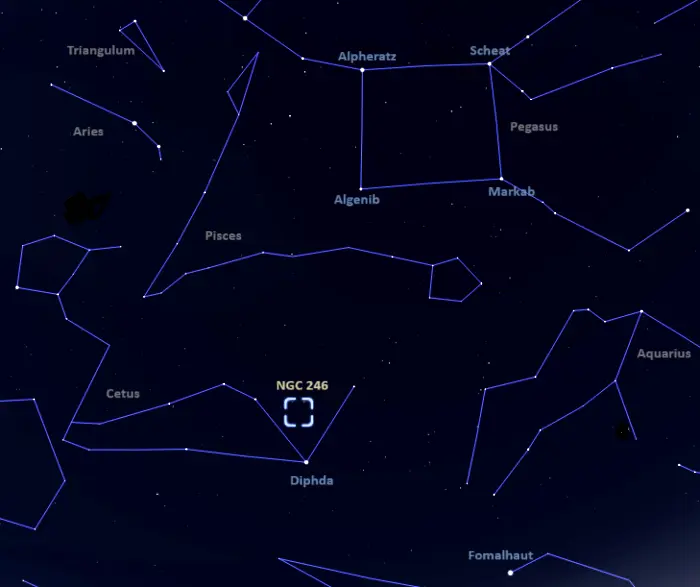
The location of the Skull Nebula, image: Stellarium
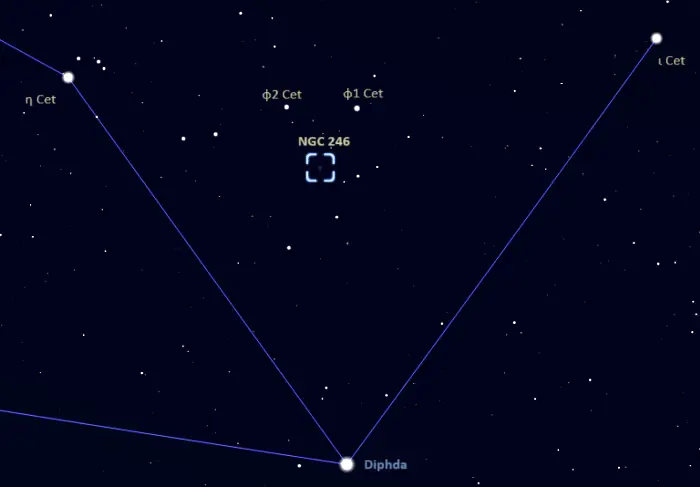
NGC 246 location, image: Stellarium
The Skull Nebula has a low surface brightness and can be a challenging object in less-than-ideal conditions. Its light can be overwhelmed by the brighter stars in the foreground when seen in a small telescope. Medium telescopes will reveal a faint round glow. The nebula is best observed in large telescopes with an oxygen III filter.
At declination -11° 52’, the nebula is visible from virtually anywhere on Earth for at least part of the year. It never rises from locations north of the latitude 78° N.
The nebula is best seen during the northern hemisphere autumn and the southern hemisphere spring. The best time of the year to observe NGC 246 and other deep sky objects in Cetus is during the month of November, when the constellation is high above the horizon in the evening.
Skull Nebula – NGC 246
| Constellation | Cetus |
| Right ascension | 00h 47m 03.3420341616s |
| Declination | −11° 52′ 18.971126076″ |
| Apparent magnitude | 8 |
| Apparent size | 3.8′ |
| Distance | 1,600 light-years |
| Radius | 2-3 light-years |
| Names and designations | Skull Nebula, NGC 246, Caldwell 56, PN VV 4, PN G118.8-74.7, PN VV’ 7, ARO 43, PMN J0047-1152, 2E 178, IRAS 00445-1207, HIP 3678, WD 0044-121, TYC 5272-1890-1, Gaia DR2 2376592910265354368, Gaia DR3 2376592910265354368, CCDM J00471-1152A, IDS 00420-1225 A, WDS J00470-1152A |